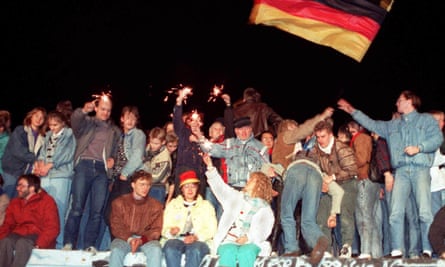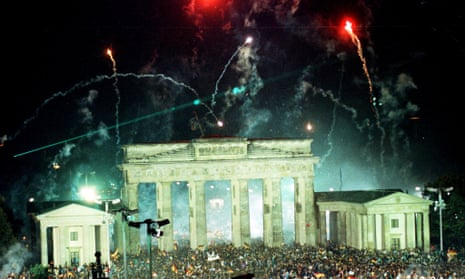Major differences between the lives and attitudes of Germans in the west and east of the country persist 30 years after reunification, a range of studies released for the October anniversary show.
From wages to childcare, trust in political leaders and state institutions, to the importance of an east or west identity, the gaps are stark, the government ombudsman for the former communist East Germany (GDR), and author of the main report, said. “I had hoped that in this, the 30th year after German reunification, we would be further along than we are,” Marco Wanderwitz admitted.
The reports’ findings make for sobering reading ahead of the key anniversary on 3 October, when the country will celebrate the reunification of the two Germanies divided by 41 years of the GDR and 28 years of the Berlin Wall.
Among the biggest variations between the former east and west are in the workplace. While eastern Germans are less likely to hold leadership positions across Germany, eastern German women are more likely than their western counterparts to have top manager posts. And while western German women earn 21% less than men, in the east it is just 6%.
A year after unification, only 55% of western German women had paid employment, compared with 67% of eastern German women, according to a study by the Hans Böckler foundation of the union DGB. But 30 years on, the number of western German women in jobs is about 72%, and eastern German women 74%.
In both parts of the country, women are responsible for most childcare and housework, and are far more likely to be in part-time jobs than men. But the legacy of state childcare in eastern Germany, which, although it has reduced since the days of the GDR remains largely intact, means 60% of eastern German women feel they have to work part time compared with as many as 80% of western German women.
Whilst the GDP per inhabitant in eastern Germany has risen four-fold since 1990, the average eastern German’s wage is still only 88.8% of that of a western German, and the economic power of former communist states is only 73% of those of the former West Germany, failing to reach the level even of Saarland, economically the weakest western German state. Eastern Germany also has more people out of work, lower land prices and less tax income.

“In an extraordinary manner, in many ways Germany looks like it’s still divided,” the left-leaning daily TAZ commented. It added that divisive in itself was the fact that three decades after reunification, Wanderwitz “continues to have the name ‘government ombudsman for the new states’ on his business card”, which it said made it sound as if he were “a mentor for problem pupils”.
Only broadband connections between the two parts of Germany are on a par.
The government’s report expressed concern about the “general lack of satisfaction” of eastern Germans towards politics and its representatives. And while 91% of western Germans think democracy is the “best suited form of government”, only 78% of eastern Germans feel the same.
Voting for far-right parties is considerably more prevalent in eastern Germany, where the far-right populist Alternative für Deutschland, the main opposition party in the Bundestag, has made its strongest gains.
Wanderwitz said he found the trend “extremely worrying”. “Hate and extremism are more readily found in eastern states, and trust in state institutions is also some cases is at a shockingly low level,” he said.
TimelineThe rise and fall of the Berlin Wall
Show
Second world war ends and the Red Army captures Berlin. The city is divided in half; the Soviet Union in the east, and the British, Americans and French in the west.
The Soviets begin the Berlin blockade. The following day the United States begins the Berlin air lift delivering food and fuel supplies to the city.
The Federal Republic of Germany, West Germany, is founded. Twelve days later the German Democratic Republic, East Germany, is founded.
Berlin airlift ends.
The Red Army steps in to suppress riots by East Berlin workers over work conditions.
The border between East and West Berlin is closed. Soldiers start to build the wall, at first with barbed wire and light fencing which in the coming years develops into a heavily complex series of wall, fortified fences, gun positions and watchtowers that are heavily guarded. The wall ended up being 96 miles long and the average height of the concrete divide was 11.8ft.
The wall claims its first life as a man falls trying to climb down from his top-floor flat in Bernauerstrasse in East Berlin, to reach the pavements of West Germany.
US President John F Kennedy visits the wall vowing to protect East Berlin, famously declaring "Ich bin ein Berliner" (I am a Berliner).
East and West Germany establish formal diplomatic ties.
President Ronald Reagan visits Berlin calling for Soviet leader Mikhail Gorbachev to tear down the wall.
The Pan-European Picnic takes place, a peace demonstration held on the Austrian-Hungarian border near Sopron.
Hungary opens its border with Austria. More than 13,000 refugees flee into Austria.
More than a million people attend a pro-democracy rally in East Berlin's central square. The East German government resigns within days.
The wall is pulled down as thousands of East Germans celebrate entering West Berlin.
Helen Pidd
Although the emigration of young workers from eastern Germany, which caused the population there to reduce by 2.2 million, has largely stopped, its ageing population continues to shrink, which Wanderwitz said would continue to be one of eastern Germany’s biggest challenges.
Susanne Dähner, of the Berlin Institute for Population and Development and author of the study Diversity of Unification, said: “Despite all the successes in the unification process, the former division is still felt in the lives of people in the east and west.”
She said that four in 10 eastern Germans felt treated as second-class citizens and that their origins played a bigger role in their lives than those of western Germans, “even in the generation of those who were born into a united Germany, who will only have learnt about that co-existence from hearing descriptions and from history books”, she said.
“Their lives were changed by reunification, their biographies were interrupted and many people had to orientate themselves anew.”
